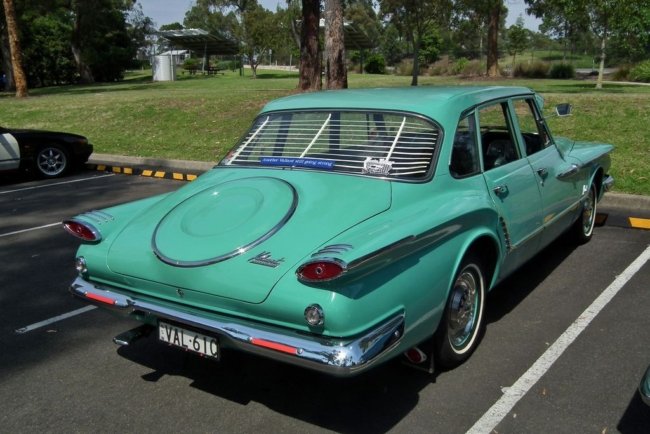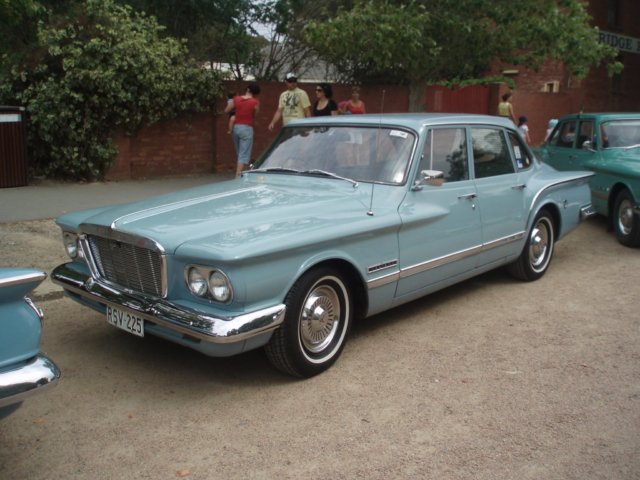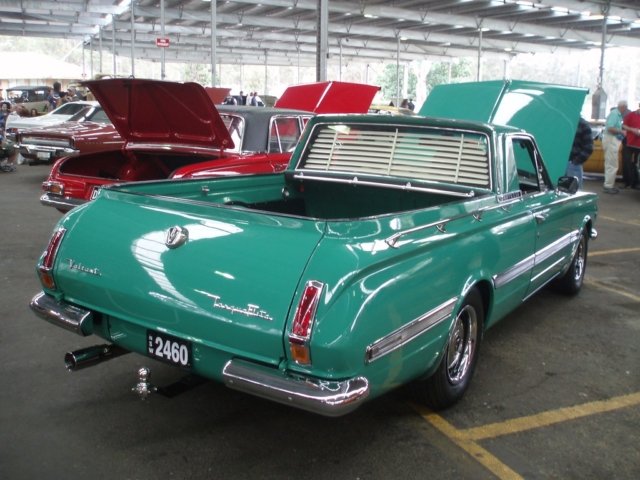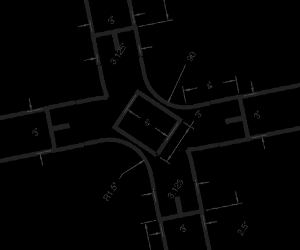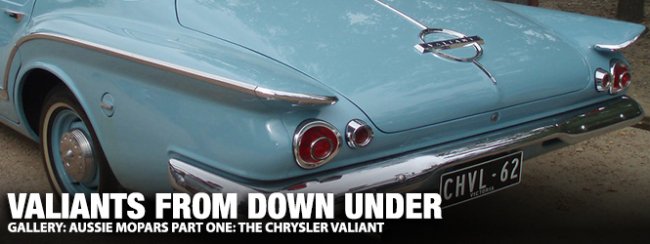
1962. The Beatles release their first recoding. Brazil wins the World Cup. Andy Warhol paints a can of soup. US President John F Kennedy announces plans to send American Astronauts to the moon, following the success of John Glenn’s orbital spaceflight. And Nikita Khrushchev, First Secretary of the Central Committee of the Communist Party of the Soviet Union, installs nuclear missiles in Cuba.
In Australia, the 10 million strong population still trades in pounds, shillings and pennies. Prime Minister Robert Menzies oversees the federal voting rights of indigenous people as well as Australia’s entry into the Vietnam War, and a new car makes a wildly successful debut: The Chrysler Valiant. That nomenclature may sound strange, and indeed the seemingly random and chaotic mixing of brand and model names from under the Mopar umbrella is a feature of the Chrysler Corporations’ presence in the land down under.
Above Left: RV1 Valiant, Image: Flickr Above Right: RV1 Valiant, Image: Pintrest
Assembled in Australia from knock down kits based on a combination of trim levels of American Plymouth Valiants, the Chrysler RV1 or simply ‘R Series’ Valiant was an instant success. Market placement played a huge role, as the R Series Valiant was supplied with the larger 225 cubic inch slant six instead of the usual 170, and 14 inch wheels were fitted as standard.
As a result, power, ride and handling were far ahead of the competition, more than justifying the slightly higher price and casting the Valiant as a desirable premium product. The initial batch of just over 1,000 cars sold out very quickly, setting the scene for the next few years as supply simply could not keep up with popular demand. Chrysler Australia had hit upon a winner.

Above: AP3 Chrysler Royal, Image: Flickr
In order to fully appreciate the impact of the Valiant’s introduction to Australia, the context of earlier history is required. Chrysler did have a presence in Australia before 1962, and a fairly extensive one at that. Local production has roots right back to 1928, when bodies for imported Chrysler chassis were built by the T.J. Richards & Sons outfit.
1935 saw the formation of Chrysler-Dodge-De Soto Distributors Australia, by a group of previously independent agents. A controlling interest in T.J. Richards & Sons was purchased, and production began on the country’s first all steel sedan bodies in 1937. World War II soon arrived and like virtually all manufacturing firms, production was quickly refocussed on the war effort.
Above Left: AP5 Valiant, Image: TradeUniqueCars Above Right: AP5, Image: Shannons
In 1948 at the beginning of the post World War II boom, General Motors’ Australian subsidiary Holden produced the 48/215 sedan, otherwise known as the FX Holden. This was the auspicious beginning of genuine local manufacture of cars in Australia.
After retooling for automotive production in 1945, Chrysler-Dodge-De Soto Distributors was ultimately acquired by the Chrysler Corporation in 1951, and renamed Chrysler Australia Limited. The Mopar marques now had an official Australian operation, fully backed by the USA.
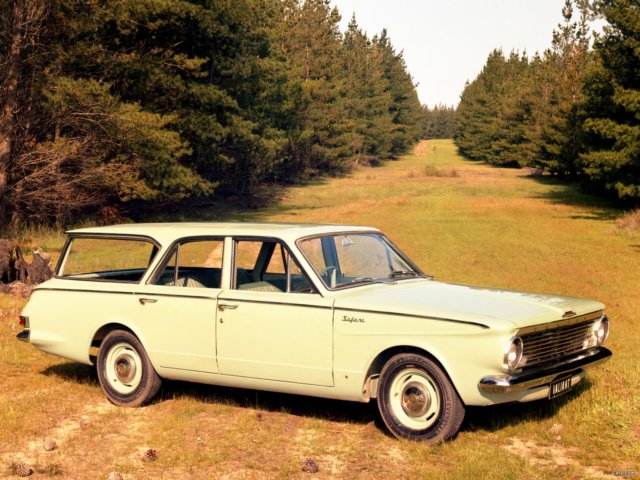
Above: AP5 Safari, Image: FavCars
Throughout the 1950s, a variety of fully imported, locally assembled and partially locally produced American based cars were sold by Chrysler Australia, and chief among them was a prime example of the badge engineering to come: The Plymouth (and to a lesser extent DeSoto and Dodge) based 1957 AP1 Chrysler Royal.
Built around a 1953 U.S. Plymouth P25 platform, the AP1 and subsequent AP2 and AP3 Chrysler Royals had a mixture of parts and body styling from later model Mopars. The first AP1s were powered exclusively by 230 and 250 cubic inch sixes, and later in the model’s production run the 313 cube Poly V8 was added as an option. They were available with power assisted brakes and power steering, luxury advancements for Australian cars at the time.
Above Left: SV1 Valiant, Image: Flickr Above Center: SV1 Valiant, Image: Flickr Above Right: SV1 Valiant, Image: Flickr
The AP2 replaced the AP1 in late 1958, and was mostly composed of cosmetic changes and some suspension upgrades. 1960 brought the final Royal, the AP3, which was produced all the way into 1964. This model featured more substantive styling changes, including an extra pair of headlamps underneath the prior model’s single pair.
The instrument cluster went from round to rectangular, and the 3 speed Torqueflite Push Button automatic transmission replaced the two speed. Wagon and half ton pickup (or ‘ute’ in Aussie-speak) variants of the Royal were also made, but the wagon in particular sold poorly, and the ute slowly enough that its production did not last as long as the much more popular sedan.
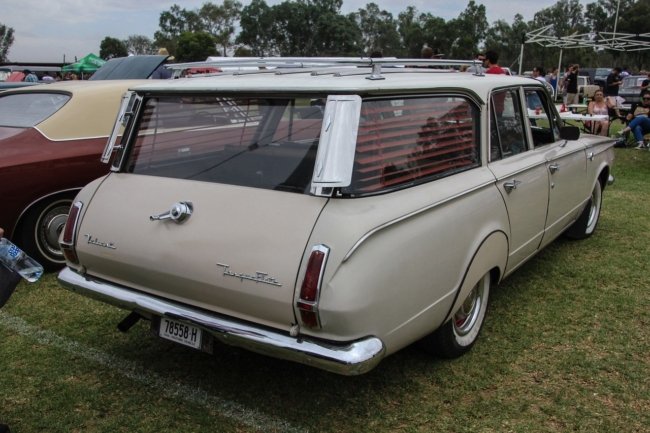
Above: AP6 Safari, Image: Pintrest
In 1960 Chrysler Australia began local assembly of the Dodge Phoenix, based on a Dodge Dart with various Plymouth parts. These were a cut above the Royals, with their 318 engines and more modern stance. In time they outsold the Royals and the regularly updated models were available through to the early 1970s. But ultimately all of these larger Aussie Mopars were overshadowed by the introduction of the compact R Series Valiant, and the models that succeeded it.
Following those 1,000 R Series Valiants were the very similar S Series models. Over 10,000 were sold from late 1962 into 1963, despite a price hike. Various changes somewhat “normalised” the S series from its slightly radical predecessor, such as the removal of the fake spare wheel moulding in the trunk lid, circular tail lights replacing the more exotic fin mounted units of the RV1, and a column shifter in place of the long looping floor shifter for the manual cars.
Automatics remained pushbutton, and a number of mechanical improvements were made such as better brakes and chassis lubrication, and importantly for Australia a larger gas tank to accommodate the relatively thirsty slant six.
Above Left: AP6 Wayfarer, Image: J Glass For Classics Above Right: AP6 Wayfarer, Image: Flickr
Mid 1963 brought the AP5 Valiant, with a lot more local content and manufacturing, including the body. A new purpose built factory was commissioned for this model, and the range grew. The AP5 was now also available in a more luxurious Regal trim, and a station wagon known as the Safari. Styling continued to move in a more conventional direction, and a host of mechanical changes were made. Nearly 50,000 cars were made, but demand was higher.
The AP6 Valiant introduced in 1965 received a very minor facelift, with the major styling change being a more interesting Barracuda style front grille. In yet another progression to convention, the pushbutton auto was dropped in favor of the industry standard column shifter. The model range was expanded further, with the addition of the Wayfarer ute, to compliment the sedan and wagon.
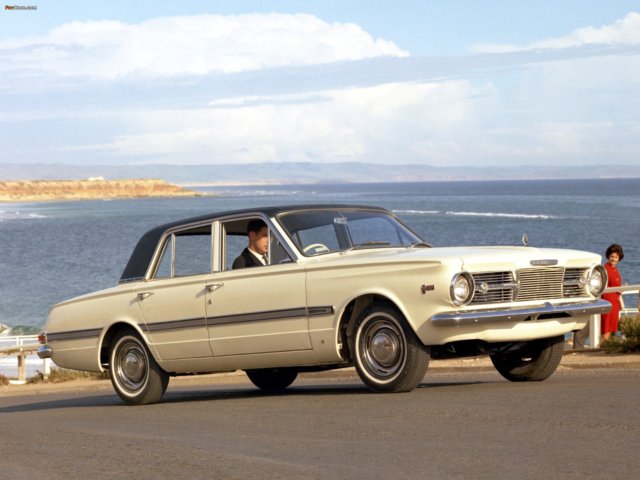
Above: AP6 Valiant V8, Image: FavCars
It was the AP6 model that ushered in the first substantive engine changes to Australian Valiants. The slant six was given a bigger camshaft, and was now also offered in a double barrel carburetor 160hp version. But of most significance was the addition of the 273 V8, an option that gave the Valiant a top speed of around 110 miles per hour.
This put it far ahead of the competition. Despite being available only with an automatic transmission, the front bucket seats and a short throw floor shifter added to the performance character of the car. Australia’s horsepower race had begun, and Chrysler Australia had both kicked it off and taken a firm lead.




